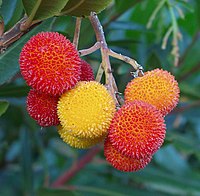
Photo from wikipedia
Goosegrass is a problematic weed species in Florida vegetable plasticulture production. To reduce costs associated with goosegrass control, a post-emergence precision applicator is under development for use atop the planting… Click to show full abstract
Goosegrass is a problematic weed species in Florida vegetable plasticulture production. To reduce costs associated with goosegrass control, a post-emergence precision applicator is under development for use atop the planting beds. To facilitate in situ goosegrass detection and spraying, tiny- You Only Look Once 3 (YOLOv3-tiny) was evaluated as a potential detector. Two annotation techniques were evaluated: (1) annotation of the entire plant (EP) and (2) annotation of partial sections of the leaf blade (LB). For goosegrass detection in strawberry, the F-score was 0.75 and 0.85 for the EP and LB derived networks, respectively. For goosegrass detection in tomato, the F-score was 0.56 and 0.65 for the EP and LB derived networks, respectively. The LB derived networks increased recall at the cost of precision , compared to the EP derived networks. The LB annotation method demonstrated superior results within the context of production and precision spraying, ensuring more targets were sprayed with some over-spraying on false targets. The developed network provides online, real-time, and in situ detection capability for weed management field applications such as precision spraying and autonomous scouts.
Journal Title: Scientific Reports
Year Published: 2020
Link to full text (if available)
Share on Social Media: Sign Up to like & get
recommendations!